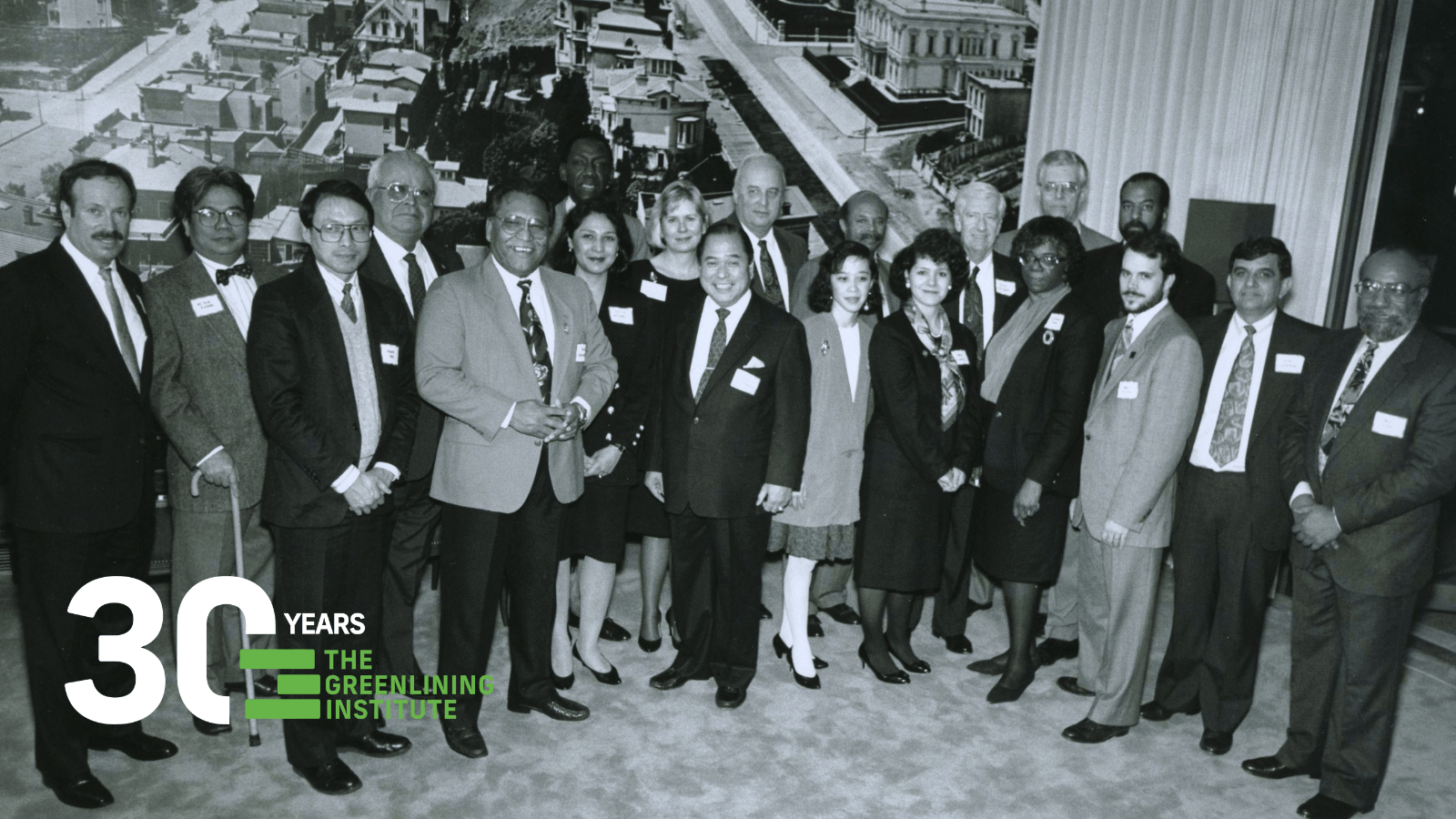COVID-19: How to Reimagine Public Transit on Our Road to Recovery

Imagine you’re a health worker or a grocery store clerk who does not own a car, but you still need to get to work to keep people healthy and well fed. If you’re neither of these but still count on having a fully staffed hospital and a sufficiently stocked grocery store over the coming months, then you should care about the state of public transit across the country.
Public transit is a pillar of a fully functional public health care system. It is critical in our fight against COVID-19 and to long-term recovery efforts. We rely on our essential workers to hold up our fragile society and economy, to keep our country well-resourced, connected, and safe, and many of these essential workers are low-income, transit-dependent, and don’t have the luxury of working from home. This also has huge racial equity implications: Asian-Amerian and African-American workers commute by public transit at four times the rate of White workers, while Latino workers rely on public transit at three times the White rate. If public transit fails, we will all fail because vital workers won’t be able to perform their duties.
We applaud public transit agencies that have dutifully kept their buses and trains running to ensure that transit-dependent essential workers can still get to their jobs to keep us all safe and healthy. Some California transit agencies, such as the Bay Area’s AC Transit and the Valley Transportation Authority, are already offering free fares and requiring back door boarding to protect drivers’ health. Yet, the ability for public transit agencies to sustain this level of service without additional funding looks grim.
With ridership significantly down, this loss of fares is further squeezing the already tight budgets of public transit agencies. TransitCenter estimates that reduced fare revenue and the potential tightening of local and state budgets could result in a financial impact of $26-$38 billion annually on U.S. transit agencies.
Public Transit’s Funding Problems Predate COVID-19
But let’s be clear: The reason that public transit is so susceptible to losses in fare revenue isn’t just COVID-19, it’s decades of chronic underfunding. Federal and state government neglect of this essential service has forced local and regional governments to increasingly rely on more precarious funding sources such as fares and sales tax measures. Dwindling economic activity and consumer spending mean that many public transit agencies will face long-term financial strain and will be forced to make tough decisions.
What would happen if public transit was forced to completely suspend services due to lack of funding? How would transit-dependent essential workers get to their jobs? What would this mean for seniors or people with disabilities who cannot drive, but desperately need to access health services? Our country’s disjointed response to COVID-19 has already caused irreversible damage. A grinding halt in public transit service would only further paralyze our recovery efforts.
“Our country’s disjointed response to COVID-19 has already caused irreversible damage. A grinding halt in public transit service would only further paralyze our recovery efforts.”
HANA CREGER
This pandemic and looming recession are teaching us a vital lesson about why we need a more resilient transportation system that can continue to operate in times of crisis when we need it most, whether a pandemic or natural disaster. We’re learning about the importance of funding public transit with sources that hold strong in the face of crisis. It’s a design flaw that our public transit system comes close to falling apart the minute that ridership dips or when a recession forces struggling Americans to minimize their purchases.
But it doesn’t have to be this way. Local governments should not have to pass off operating costs onto transit riders and everyday citizens. Federal and state governments must finally step up and fund public transit service at levels that keep it resilient in the face of disaster. These coming weeks and months will be challenging for all of us — yet we need public transit to remain fully functional in order to help essential workers to protect us and keep our economy afloat in these turbulent times.
Greenlining and many of our transportation justice allies have signed onto a joint letter developed by TransForm and ClimatePlan that urges Governor Newson and California legislators to enact TransForm’s recommendations below.
What We Need Now: Immediate Solutions to Protect Public Transit
In the short term, here’s how we can drastically improve public safety and financial sustainability of California transit agencies:
1. Immediate fare-free service. With this increased flow of emergency transit dollars, we call for these funds to be targeted towards waiving fares. This will both help essential workers get to their jobs and reduce close contact between riders and drivers.
2. Prioritize emergency transit funding. While the Federal stimulus bill is close to providing $25 billion in aid for public transit nationwide, that is not nearly enough to keep transit functional for long. California must also step in to secure emergency funding. We suggest tapping into these funding sources:
- Pass emergency legislation that temporarily moves all funds from the Transit and Intercity Rail and Capital Program, a competitive grant program for large capital projects, to the Low Carbon Transit Operations Program, state funding that is distributed to nearly every California transit agency. California must shift funding from expanding new transit stations to instead prioritizing immediate, essential bus and rail operations. This reallocation could produce over $1 billion per year, and will be essential to help us weather this social and economic crisis.
- Redirect all legally-moveable funds (minus bicycle and pedestrian projects) from the State Transportation Improvement Program, and a minimum of 30 percent of the Trade Corridor Enhancement and Solutions for Congested Corridors programs, to transit operations. This transfer would provide $180 million to keep transit running, while maintaining funding to improve biking and walking infrastructure — which is critical to keep our population healthy and well-connected to transit.
What We Need in the Future: Long-term Strategies to Ensure Recovery Efforts Reach Low-Income Residents
In the long term, here’s how to bolster public transit ridership to help propel California’s recovery efforts from COVID-19:
1. Support permanent free transit passes for vulnerable riders. Using the funding sources listed above, formally establish fare-free transit passess for youth, college students, and seniors. This approach is a critical part of the recovery package that will help vulnerable populations get back to school, jobs, and to health care.
2. Establish a universal transit pass. California should put into place a statewide transit pass system where the fares of transit riders would be collected into one single revenue pot. This universal system would more easily allow vulnerable populations to receive discounted or free fares. It could work like the Bay Area’s Clipper Card, which is a reloadable fare card that is attached to a persons’ identity, and is capable of providing flexible payment options and fare-caps.)
These strategies would support our public transit agencies by giving them the levels of funding they deserve and allowing them to ease their dependence on fares during this recovery. Even once the pandemic shows signs of slowing down, people will rightfully be nervous to get back onto trains and buses, so we must do everything in our power to support transit agencies by encouraging increased ridership. Improved operations and fare-free service will be a strong incentive. Transportation costs are the second highest expense for Californians, after housing. Since March 13 alone, 1 million Californians have filed for unemployment. In the months to come, families will be faced with mounting financial pressure as they seek to find new jobs and return to school. Fare-free service for youth, students, and seniors is a small price to pay to keep more cash in the pockets of families.
The benefits of fare-free public transit for vulnerable populations extend beyond just relieving struggling families and jumpstarting the economy. We have an opportunity to usher in generations of dedicated transit users. Studies show that when young people ride public transit, they are much more likely to become life-long transit users. This is a critical long-term strategy to lowering climate emissions and traffic congestion. Since implementing a fare-free program for students, Sacramento Regional Transit District has seen student ridership double — even on weekends which indicates that students use transit to access jobs and recreational activities. Lifting the burden of transportation costs will improve access to opportunities for young people, whose futures have been stolen from them by the looming threats of unaffordable livelihoods, unimaginable student debt, and climate change. Fare-free transit for vulnerable populations tackles poverty and pollution, while improving access to jobs, education, and healthcare all at the same time.
“This is a moment where we can choose to either maintain the status quo, or to reimagine public transit as we know it.”
HANA CREGER
These bold strategies represent the types of audacious ideas that we need to both mitigate this crisis and to chart a path towards recovery. As we shape our recovery, we must think beyond just defeating the pandemic — because we will still be faced with the climate crisis. As our world finally transitions back into a sense of normalcy, we’ll likely see worsening poverty rates in California. That’s why we need more than just temporary relief for struggling families. We have to envision an intentional, long-term strategy that improves peoples’ mobility while cutting climate emissions and improving access to economic opportunities for years to come.
If California is serious about tackling COVID-19, we need bold action to support public transit. While something of this scale has never been done before — no U.S. state has ever enacted something as transformative as free transit for youth, students, and seniors. But that is what California is known for: taking bold action where no one else would ever dare. We’ve done this on climate change, and now it’s time to take a bold stance on public transit.
California, this is not the time to step back in the face of fear, but a time to step forward to build a resilient transportation future.




